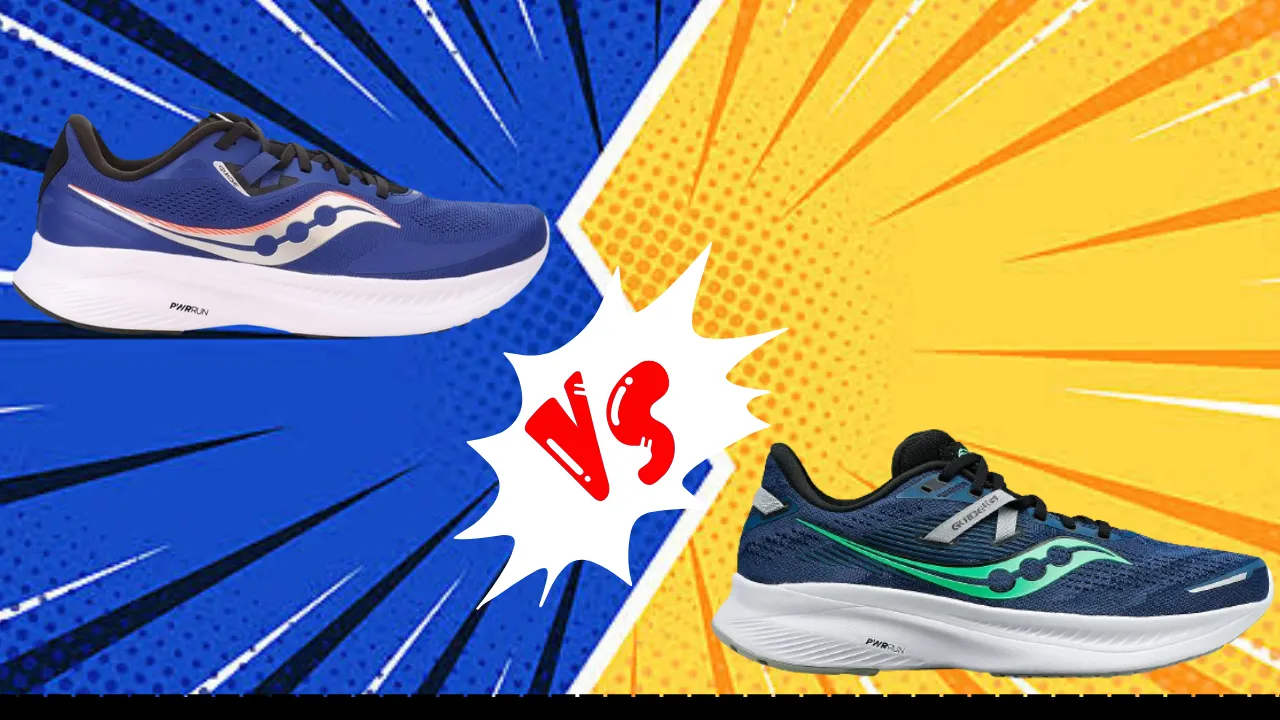The Saucony Guide series has long been a go-to option for runners seeking a stable, supportive daily trainer. Guide 15 and 16 are two of the latest versions, providing moderate support and cushioning.
In this in-depth comparison, we break down the key differences between these two models to help you determine which one is better for your needs and running style.
Similarities And Differences Between Saucony Guide 15 And Guide 16:
| Feature | Guide 15 | Guide 16 |
|---|---|---|
| Launched In | 2022 | 2023 |
| Stability | Medial post, firm midsole | Medial post |
| Flexibility | Moderate | Moderate |
| Sizing | Standard | Runs slightly narrow |
| Weight | 10.6 oz (M), 9.2 oz (W) | 9.5 oz (M) |
| Cushioning | PWRRUN | PWRRUN |
| Outsole | XT-900 rubber | Rubber |
| Midsole | PWRRUN | PWRRUN |
| Upper | Engineered mesh | Engineered mesh |
| Retail Price | $110 | $140 |
Features Comparison
Materials:
The outsoles on both Guide 15 and 16 are made of durable rubber to provide traction. The Guide 15 uses XT-900 rubber while the 16 uses a standard rubber outsole.
The midsoles on both models utilize PWRRUN foam which provides responsive cushioning and energy return. PWRRUN is a lightweight, durable foam that maintains its cushioning properties over time.


The upper on both shoes is an engineered mesh that aims to provide breathability and structure. The engineered mesh uppers are comfortable while also providing a secure fit.
The Guide 16’s upper does run slightly narrower than the 15’s more spacious fit. Inside, both models have a removable insole to accommodate custom orthotics if needed.
Durability:
In terms of durability, both Guide 15 and Guide 16 are built to last. The PWRRUN midsole foam maintains its cushioning and bounces even after many miles of wear.
The outsoles are also extremely hardy, with the Guide 15’s XT-900 rubber providing particularly impressive longevity. The engineered mesh uppers are dense and structured to prevent tearing or blowouts.
Some testers did report that the Guide 16’s upper seemed slightly less durable than the 15’s, with a few observing early signs of wear around the forefoot. However, the difference was quite minor.
Overall, both models provide excellent durability that easily meets or exceeds the 300-500 mile lifespan expected of most daily trainers. Runners of all levels will get their money’s worth from these sturdy, well-constructed shoes.
Fit:
The Saucony Guide 15 has a relatively spacious fit in the toe box and midfoot, offering room for modest foot swelling on longer runs. The fit is secure but not overly snug.


Meanwhile, Guide 16 runs at least a half size smaller due to its slightly narrower engineered mesh upper. The midfoot and forefoot are tighter and less forgiving than the previous version.
Both shoes have decent heel lockdown thanks to external support frames and padded collars. However, the Guide 15 may offer better heel security for runners with narrower heels.
Those with wide feet will likely prefer the roomier toe box of the 15 over the 16’s more tapered forefoot fit. Trying both models in-store is recommended to gauge the ideal sizing and fit. Those with wider feet should strongly consider sizing up in Guide 16.
Stability:
As expected from the Guide series, both models provide excellent stability for moderate overpronators. The Guide 15 uses a firmer medial post and midsole density in conjunction with the 8mm offset to prevent excessive rolling inwards.
The Guide 16 utilizes a traditional medial post along with GUIDERAILS technology in the midsole to add structure without compromising cushioning and flexibility.
Testers found both shoes effectively supported and guided their feet during transitional phases of the gait cycle. The stability feels slightly more pronounced in the Guide 15, while the 16 offers a more seamless underfoot experience.
However, the overall support and correction for overpronation are excellent in both versions. Neutral runners may also appreciate the subtle medical support provided.
Cushioning:
The Guide 15 and 16 offer very comparable cushioning with their PWRRUN midsoles. This proprietary foam delivers responsive shock absorption and energy return without an overly soft or mushy feeling underfoot.
The stack height is slightly reduced in Guide 16 (from 28mm to 26mm in the heel), but most testers couldn’t discern a major difference in cushioning or softness.
Both provide sufficient comfort for daily runs up to an hour or longer. The firmer density means these shoes are not as plush or cushioned as dedicated neutral shoes like the Triumph or Ride.
The Guide 16 gets a slight edge for feeling more consistent and responsive through the full length of the shoe. The Guide 15 loses some bounce in the latter stages of its lifespan.
For heavier runners or those wanting maximum cushioning, trying out the Ride or Triumph may be preferable. But for a stable daily trainer, both Guide models tick the boxes for cushioning.
Value:
With an MSRP of $110, the Guide 15 offers exceptional value given its premium construction, ample stability, and durable cushioning. Similarly, the Guide 16 justifies its $140 price tag with enhanced upper comfort, smoother transitions, and consistent cushioning delivery. The price increase from the 15 to 16 models is reasonable given the performance improvements.
Compared to similar stability models like the Kayano, Adrenaline GTS, and Precision, the Guide series is competitively priced – delivering comparable technology and performance at a more affordable cost.
While not the most budget-friendly option, both Guide 15 and 16 are worthwhile investments for runners seeking a supportive daily trainer that can easily handle high mileage. The value is especially apparent when considering the impressive 300-500 mile durability of each shoe.
Performance Comparision:
Walking:
The Guide 15 and 16 both perform well for walking and casual use, thanks to their comfortable uppers and cushy midsoles. The engineered mesh provides a secure yet non-restrictive feel ideal for all-day wear. Testers found both shoes required almost no break-in period to feel pleasant right out of the box.
The Guide 16 gets a slight edge for walking comfort with its well-balanced cushioning and smooth heel-to-toe transitions. However, casual walkers would be happy in either shoe. The support is not necessary but also does not interfere with enjoying a stroll.
Running:
As expected, both models excel as daily running trainers. The Guide 15 feels dense and supportive underfoot – ideal for moderate overpronators who prefer a corrective, guiding feel.
Meanwhile, Guide 16 offers smoother transitions and consistent cushioning delivery for neutral and stability runners alike. The breathable uppers keep feet cool and dry across various speeds and distances.
The Guide 16’s improved energy return creates a notably responsive sensation that helps push the pace on tempo runs or strides. The 16 also holds up better for faster paces than the 15, which starts to feel flat when pushed below 7:00/mile.
For casual jogging, long runs, and varied training, either model works well. Performance-focused runners who plan to use these shoes for speedwork as well may prefer the snappier ride of the Guide 16.
Plantar Fasciitis:
The firm cushioning and stability features of the Guide series make both the Guide 15 and Guide 16 decent options for runners with plantar fasciitis. The medial support in these shoes helps control pronation and inflammation. Testers found the Guide models provide adequate arch support and relief from PF pain.
However, they lack custom insoles or targeted PF technology found in some other shoes. Trying orthotic inserts may further aid comfort. Overall, while not ideal, the Guides 15 and 16 provide a solid alternative to explore for plantar fasciitis sufferers needing stability and support in their daily trainer.
Standing All Day:
Nurses, teachers, retail workers, and others on their feet all day noted mixed results from Guide 15 and 16. The comfortable uppers and cushioned midsoles provide welcome relief from hard floors initially.
However, some found the firm ride caused foot soreness and fatigue over 8+ hour shifts. Trying outsole-focused walking shoes may better suit all-day standing.
That said, those whose jobs involve light walking or movement may appreciate the secure lockdown and support of the Guide models versus flatter, more flexible options. Overall, they can work for long hours on your feet but may not be the ideal choice.
Final Verdict:
For runners needing a balanced stability shoe for daily miles and training, both the Saucony Guide 15 and Guide 16 are excellent options to consider.
Guide 15 provides firmer guidance and correction that moderate overpronators will appreciate. The 16 offers enhanced energy return and a more seamless ride for a wider range of runners.
While sizing varies slightly between models, their durable constructions, comfortable uppers, and stable PWRRUN midsoles deliver reliable performance. The Guide 16 gets the edge for runners seeking a responsive, well-cushioned stability shoe capable of handling a variety of paces and distances.

